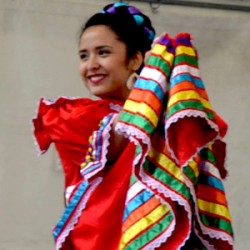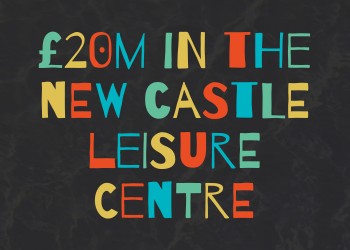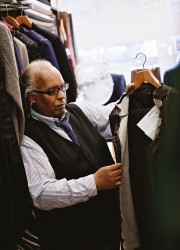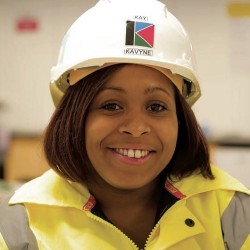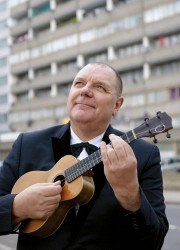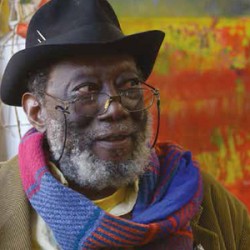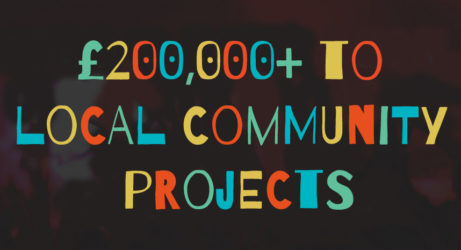Taking a turn off East Street to reach Sokari Douglas Camp’s live-work studios, you leave behind one kind of street theatre, comprising stallholders and shoppers, only to enter another, this time made-up of large metal figures; static and yet, somehow, every bit as animated.

Literally skipping out of her home-cum-workshop, Sokari is certainly animated herself. Warm and welcoming; her boundless enthusiasm and giddiness belies her 62 years.
Once inside the building (which was designed and built by her architect husband, Alan Camp) you’re immediately struck by an array of sights which represent different aspects of Sokari’s life.
A spiral staircase, guarded by a life-size, steel palm tree, dominates the scene – climbing three floors up to the broad glass ceiling. Giant steel sculptures of various characters form a kind of reception committee, while a number of portraits, painted by her two daughters, add an additional, family touch.
The metal figures – which sit at the heart of much of Sokari’s work – take inspiration from her Nigerian roots, her Kalabari heritage and life in Britain and Elephant and Castle.
Sokari’s work appears in the permanent collection at the British Museum, as well as in galleries in Washington, Tokyo and elsewhere. She has had several local, national and international exhibitions; was shortlisted for Trafalgar Square’s fourth plinth in 2003 and received a CBE in recognition of her services to art in 2005.
In the summer of 2020, the role of sculpture and statues in public life came under intense scrutiny.
With protests against the memorialising of slave traders and others, led by the Black Lives Matter movement, more people began to ask questions about who gets represented in British art and how and why.
Indeed, the council’s Southwark Stands Together initiative has already undertaken an audit of civic art and local place names as part of a broader mission to tackle racism and inequality in the borough.
“The more BLM grows, the more my statues are the kind of stuff I’d like to come across when I go for a walk in Elephant and Castle” says Sokari. “Maybe in one of the many new developments being built” she smiles.
Statues are powerful. They affect you. I should know.
“We’re at a crossroads in the national conversation about our history and, rather than adding more blue plaques, I’d rather see a huge, fat sculpture that would stop you in your tracks.” Sokari moved to Elephant and Castle in 1988 and, unlikely as it sounds, she came for the steel.
Sokari had fallen in love with the material while studying at art college. She found the best place to buy it was from Thomas Tingley, who had a factory on Brandon Street, just around the corner from where she lives now.
“Back then, Alan and I were looking for a warehouse to share with friends and this site, near Tingley’s, was empty” explains Sokari.
“I had a relative, in Camberwell, who said Elephant and Castle has fantastic connections. It’s central; you’re not far from the river; Westminster is just 15 minutes away and Burgess Park had really taken shape by then, too.”
“To begin with, we’d visit and we’d get lost. It was the end of the Bakerloo line and we didn’t really know where we were. But after a while, it became apparent that the end of the line was actually the beginning of the line for us.”

Sokari’s own personal line begins in Buguma, Rivers State, Nigeria.
Born the daughter of a chief, she was brought up by an English anthropologist, Robin Horton who had married her elder sister.
“It was tragedy that gave me the luck I had” says Sokari.
“My sister died in childbirth and they lost their twins too. Robin was distraught and so, to keep himself together, he stayed with the family and asked that he might bring me up because I was living with them at the time.”
That early, anthropological influence – a curiosity about how we look at people, society and culture – has become one of the mainstays of Sokari’s work, alongside a desire to address injustice.
Her piece, Green Leaf Barrel (2014) was inspired by the struggles of people living in the Niger Delta, facing mounting unemployment as well as terrible pollution. Another piece, a full-scale replica of a bus – Ken Saro-Wiwa Living Memorial Bus – honours the life of the famous writer and environmentalist who was executed by Nigeria’s military government in 1995.
Her collection of six sculptures, entitled All the World is Now Richer, addresses themes of slavery, evolution and change, and is currently exhibited in Parliament.
Sokari is alive to the change and evolution taking place in her own neighbourhood too.
She laments the loss of the Heygate estate (“it had the best views in London”) and questions the need to build upwards (“what’s wrong with horizontal?”) but, nonetheless, Sokari says she’s been looking forward to seeing the area develop.
“I hope the area continues to have a cosmopolitan feel” she says. “The people around here are so exciting. But I’d like to see more, green community space so that local businesses and people can thrive. And that should include more art, too.”
“Living and working in Elephant and Castle, I love knowing that I’ve had work – inspired by this area – exhibited in some prestigious locations. I had a show called The Pleasure of Seeing You. It was based on the local, West African Pentecostal churches and these ladies that I’d see on Walworth Road, stopping traffic. I created 20 figures in total, each with an elaborate headdress.”

Warming to her theme, and reflecting on the slaver statue that was torn down in Bristol, Sokari says “Statues are powerful – they affect you. I should know, I’ve had paint and stuff thrown at my work. But I don’t think you should hide statues. I’m in the game of trying to have a conversation where I affect people.”
She adds “I don’t knowingly set out to rile people but, as an artist, you hope to make some kind of statement because you’ve been touched, and you want to say ‘this is how I see things’.”
Sokari also has modest ambitions for transforming her own, little patch of Elephant and Castle. She wants to create a community garden on a small piece of land near her home, where the poet and philanthropist Robert Browning once had a hall.
The pandemic put a halt to Sokari’s schedule of exhibitions for 2020. She says “I’ve been totally freaked out – caught like a rabbit in headlights. Every single show I was in, suddenly stopped; put to the side, not going to happen this year, maybe next year.”
The pause gave her some time for reassessment, ‘a reset button’ as she calls it, nonetheless, progress on the garden has been slow. However, she takes comfort in the fact that even when the galleries and museums were closed, her own work could still be seen locally; in Great Suffolk Street, Union Street and in Peckham.
“I love it when people come across my stuff by chance. I love being seen. That is the best part of me.”
Read more about the people who live and work in Elephant and Castle
